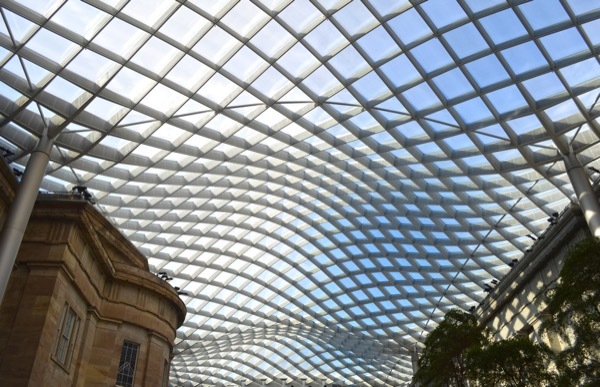Walt Whitman called this historic Greek Revival structure “the noblest of Washington buildings,” and if he were around today, he’d likely stick with that opinion. If you’ve been flitting around the Penn Quarter, you had to have noticed it, with its porticoes modeled after the Parthenon in Athens, and its monumental footprint (405 x 274 ft.).
The magnificent landmark, which served as the nation’s patent office in the mid–19th century, now houses two distinct Smithsonian museums: the American Art Museum and the National Portrait Gallery, each occupying three levels of galleries that enclose a stunning, light-filled inner courtyard.
Whitman is here, yes he is, in portrait form, painted by John White Alexander in 1889, appearing rather old and tired, with blindingly white hair, full beard, and fluffy eyebrows, sitting at an angle and staring into the distance. Whitman’s portrait hangs in the National Portrait Gallery’s first-floor section, American Origins, a chronological arrangement of paintings of notables that tells the country’s story, from Pocahontas to Harriet Beecher Stowe to Thomas Edison, in compelling fashion. Other permanent exhibits feature 20th Century Americans, where portraits of F. Scott Fitzgerald, Michael Jackson and Douglas MacArthur among others now hang, and America’s Presidents, home to President Obama’s official portrait.
The American Art Museum’s collection of American art is one of the largest in the world—and the most diverse, with folk art, modern, African-American, and Latino art well represented. Standouts include Georgia O’Keeffe’s take on Manhattan; Albert Bierstadt’s idealized vision of the American West, Among the Sierra Nevada; a Nam June Paik video installation, Electronic Superhighway: Continental U.S., Alaska, Hawaii; and intriguing folk art, like James Hampton’s creation of artwork out of garbage, The Throne of the Third Heaven of the Nations’ Millennium General Assembly. You’ll either love it or hate it, but you won’t be able to look away from it.
In all, about 2,000 works are on display throughout both museums. You’ll want to tour the top floor’s two-level Luce Foundation Center for American Art, too, where thousands more works are stored but still on view, from walking canes to sculptures to dollhouses. In the adjacent Lunder Conservation Center, visitors can watch conservators work to preserve art pieces.
Note: These two museums are open later than most in D.C., so you can schedule a visit for the end of the day.






 About our rating system
About our rating system


